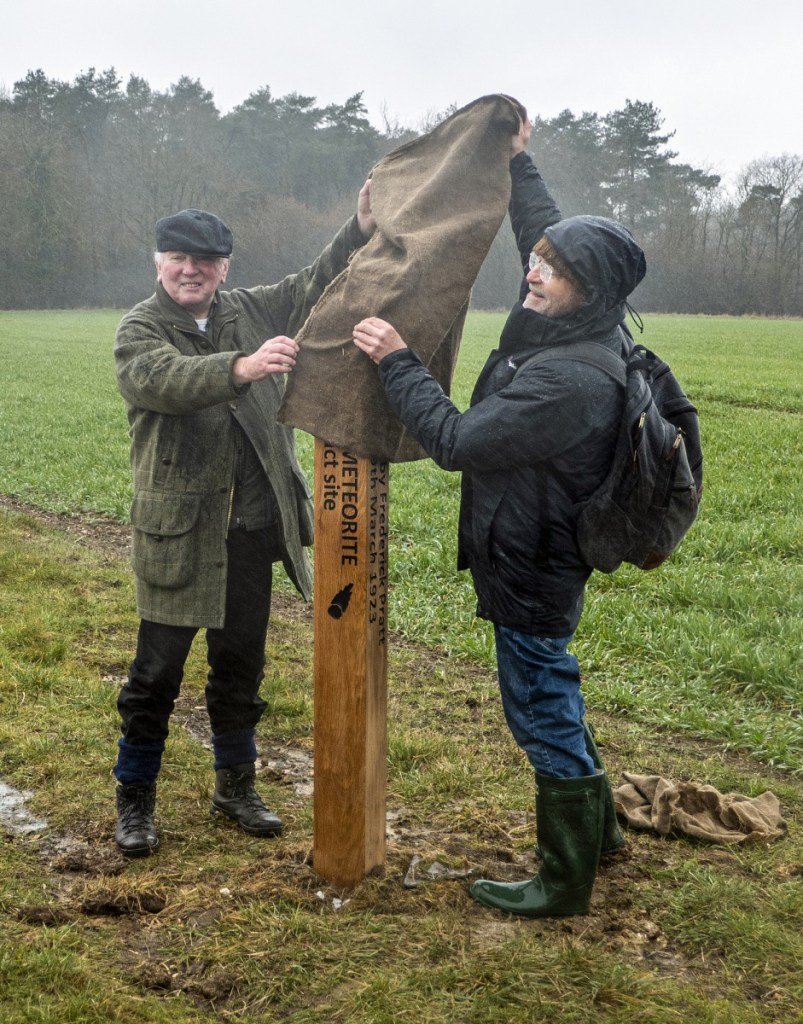Michael E Howgate
100 years in the past, a grapefruit-sized lump of rock ended its 4 and a half billion 12 months lengthy journey by house by crashing right into a subject in northwest Essex. To be extra exact, at 1pm on Friday, 9 March 1923, Frederick Pratt, a thatcher and farm labourer, heard what he described as a loud “sissing” noise, and a few seconds later noticed:
a projectile fell about ten or fifteen yards from him, inflicting the earth to spout up like water” (Information report in The Instances newspaper, 7 June 1923).
Three days later and suitably geared up, he went again to the spot with a good friend and so they dug up the ‘Ashdon’ meteorite. Being a wise chap, he knocked a bit off, presumably to examine that it was not only a widespread flint he had unearthed, and then took it to the local police station.
The Saffron Walden bobbies were not interested, so he took it home to Wendens Ambo. Here, he showed it to his vicar, the Reverend Francis W Berry who, being an alumnus of Trinity College Cambridge, showed much more interest. Berry recognised the importance of Pratt’s find and purchased it from him, so that he could donate it to the Mineralogical Department of the British Museum (Natural History).
The keeper of mineralogy, Dr. George T Prior, a noted expert on meteorites visited the site three months later with both Frederick Pratt and the Rev. Berry in attendance. (Prior’s description of the Ashdon meteorite appeared in the ‘Journal of the Mineralogical Society’ (Vol. XX, No.103) in December 1923.) Pratt was able to direct him to the exact spot of the impact, where, after a bit of searching, Prior unearthed the fragment, which had been knocked off the meteorite by Pratt. It was here that Prior took the iconic photograph of Frederick Pratt, knee-deep in wheat, at the site of the impact. (See page 7 in the centenary booklet ‘The Ashdon meteorite, the story of a stone that fell from the sky’ by Gerald Lucy and Mike Howgate, and published by the Essex Rock and Mineral Society – see below for details.)
The Ashdon Meteorite has remained in the Mineralogy Department of the Natural History Museum (NHM) ever since. That is, until the day of the centenary of its impact, when it returned to Ashdon for the day.

The idea of celebrating the Ashdon meteorite impact began about three years ago, when I had discussions with Gerald Lucy of the Essex Rock and Mineral Society. The aim was to erect a concrete pillar at the impact site and unveil it a 1pm on Thursday, 9 March 2023, to the accompaniment of the largest rocket we could acquire and a suitable explosion in the ground at the impact site.

Unfortunately, or fortunately – depending on your point of view – things were scaled back to a commemorative oak post and a meeting in the Ashdon village hall. We were doubly lucky in that the impact site was adjacent to a public footpath and that both the farmer and landowner turned out to be keen on the project. The farmer erected the post and the Ashdon Village Museum paid for it. The rest of the funding for the event, including the commemorative booklet, came from the Curry Fund of the Geologists’ Association.

Another piece of serendipity was that the Ashdon meteorite was brought to the village for the day by the curator of meteorites at the NHM, Dr. Natasha Almeida. It was even brought tothe impact site, suitably protected in Dr. Almeida’s rucksack, as 35 very damp geologists and villagers watched Gerald and me struggle to get the wet sacking off the post at exactly 1pm. Another 30 locals and visitors joined us for the commemorative meeting in the village hall, heard a very lively presentation by Dr. Almeida, and received a free copy of ‘The Ashdon Meteorite’ souvenir booklet.

The event was well reported in the local press and warranted two double page spreads in ‘Essex Life’ magazine (Essex Life, March 2023, pages 126-129). The specially prepared display panels produced for the meeting were subsequently on display at the Saffron Walden Museum, along with a cast of the Ashdon meteorite and other meteorite specimens. Ashdon Village Museum also has a cast of the meteorite and a small display on the fall.

The fully illustrated centenary booklet entitled ‘The Ashdon meteorite, the story of a stone that fell from the sky’ by project organisers, Gerald Lucy and Mike Howgate, can be obtained from Gerald Lucy (price £3 plus £2 p&p) at www.therockgallery.co.uk.
Trending Products










